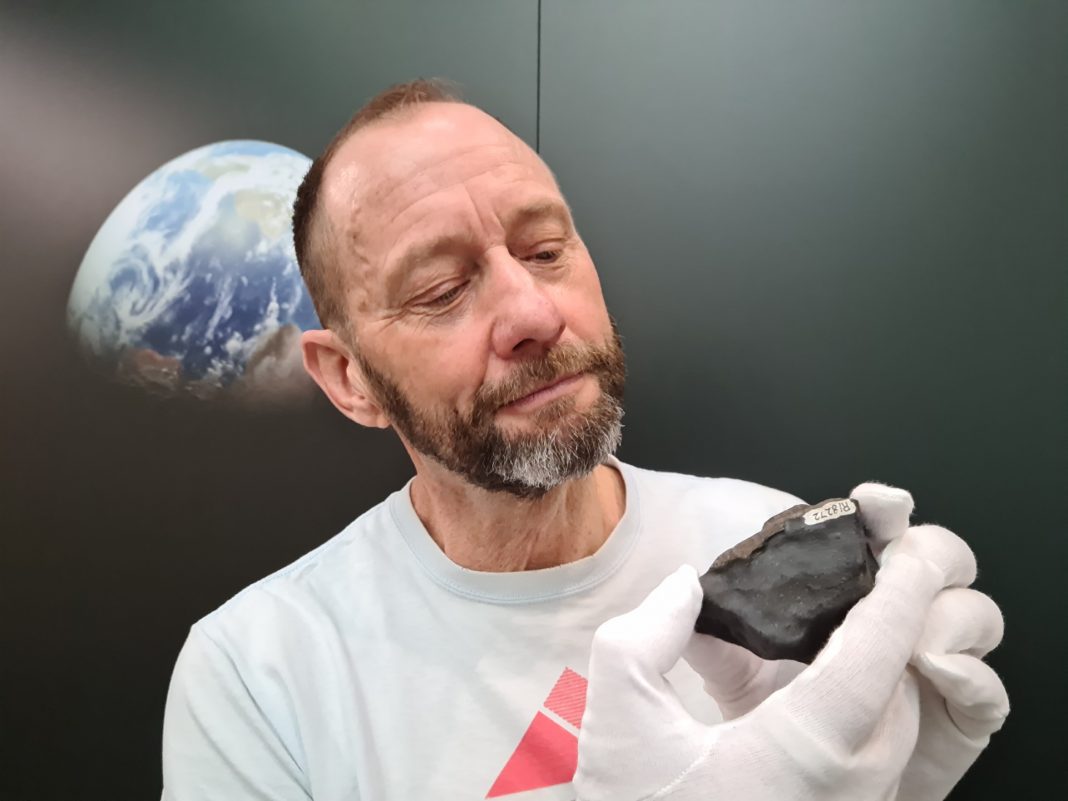Reunions can be emotional and heart-warming but here’s one reunion – after being separated for 54 years – that recently happened in Canberra. It’s out of this world.
When Higgins resident Chris Carson was eight years old and sitting on a bus in the Victorian town of Benalla, he witnessed a meteorite plummet to Earth. He never imagined one day he’d hold that seven-billion-year-old space rock as a project geologist at Geoscience Australia.

It was an emotional moment when they met again. The small boy who was on his way home from Sunday school when he saw a brilliant white flash, now grasped the Murchison meteorite with child-like awe.
“Wow, look at that, that is remarkable,” Chris said, as the meteorite fragment was taken out of a safe with protective, white gloves. “That was fantastic just to pick it up, actually, it was quite special to reconnect after having seen it fall in 1969.
“I just happened to be looking out the window, right place at the right time. It was a clear bright blue sunny sky and I saw this brilliant white flash low on the western horizon. I knew enough about space and astronomy and all of those things to realise that it was a meteorite and I didn’t think anything of it at the time.”
It’s been a long and winding road to reunite Chris and the Murchison meteorite.
The young Chris had ambitions to be an astronaut (it was the year of the moon landing) but with job opportunities scarce, Chris dropped out of astrophysics at uni and settled for something closer to home, Earth.
His academic journey took him to universities in Tasmania, Melbourne, Sydney, Yale in the US, Canada’s arctic, and finally, a job in Canberra.
Here, he locked eyes with the meteorite in a glass display cabinet in the foyer of Geoscience Australia in Symonston.
“I didn’t know there was a fragment here until I got here. It was completely coincidental,” he said. “It was that nice closure of seeing it fall when I was an eight-year-old boy … and here I am 50 something years later, being able to pick it up and hold it.”
As he holds the meteorite, he’s visibly moved and transported back to 28 September 1969.
“As soon as I hold it I can picture in my mind’s eye the flash of bright white light in a bright blue sky,” he said. “If I had’ve been looking anywhere else I would have missed it.
“When I look at this, I see that flash in my eye from over 50 years ago. I still go back to Benalla to visit my elderly mum … and I walk past the spot where I saw the flash in the sky, it looks exactly the same as what it did in 1969. It’s exciting. Here I am holding it, it’s quite remarkable.”
Chris still goes star-gazing regularly with a telescope set up at home.
“I do go out when the major meteorite showers are expected because there’s always the possibility it could be a fantastic show. “
As an adult, Chris is still filled with child-like wonder about the Murchison meteorite and so is the world. It is the most studied meteorite known.
Fragments predate the solar system
“The thing I find absolutely astonishing about this is there’s material in here that predates the solar system,” he said.
“I think that’s astonishing – half the age of the universe. There are fragments in the Murchison meteorite that are over seven billion years old, much older than the solar system and it was very special to hold something that old that represents something primordial in the formation of the universe.”
Pieces of the Murchison meteorite (fragments weighing up to 7kg were found scattered over more than 13 square kilometres) are held at Geoscience Australia and other universities.
Curator of Geoscience Australia’s National Mineral and Fossil Collection, Steven Petkovski, said the Murchison meteorite was one of the most studied meteorites known.
“Research studies into its makeup have continued over the decades with exciting new discoveries made regularly,” Steven said.
“For example, it has a water content of around eight per cent, which may hold clues as to why we have water here on Earth. Perhaps, most significantly, a recent study revealed it contains the oldest material ever found on Earth in the form of seven-billion-year-old stardust grains. This is two-and-a-half billion years older than our Earth and solar system.”
The Murchison meteorite fragment and other significant space rocks are on display and available for research at the National Mineral and Fossil collection at Geoscience Australia; www.ga.gov.au
Canberra Daily is keen to hear from you about a story idea in the Canberra and surrounding region. Click here to submit a news tip.



